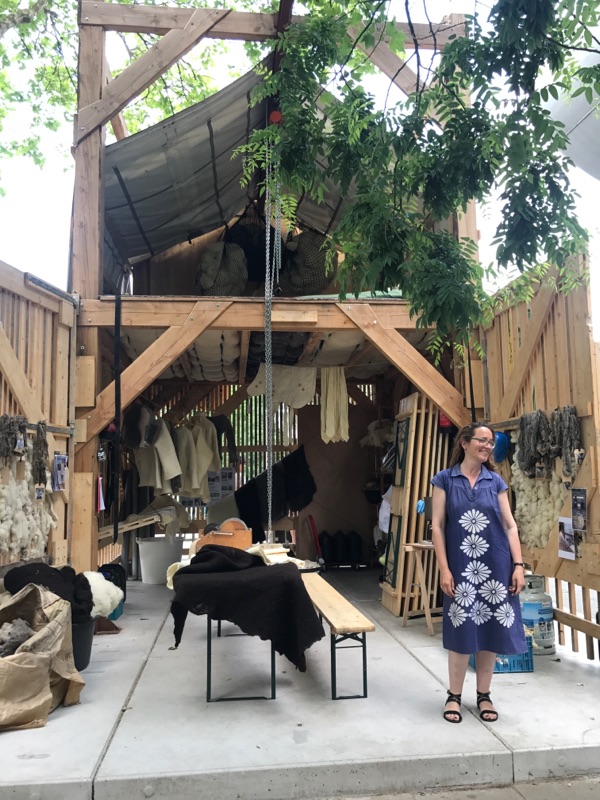photo: the Sweat(er)shop and D-stillery at the Utrecht Science Park, Cynthia Hathaway
This is a woolly research adventure of designer Cynthia Hathaway, and the Sweat(er)shop. This blog will be an archive of extending the value of wool as a social and interspecies binder, and protector of landscape and mobility. This blog will feature my interactions with a variety of people and organizations of wool, including wool recyclers, shepherds, transhumance (the walking of animals to pasture), migrant associations (those who share with shepherds the effects when mobility is restricted) and those involved with rural revitalization. The aim is to see if the Sweat(er)shop can support a wider vision to complement product production, and be a platform for interdisciplinary, multicultural and interspecies relations through wool. The following search is an exploration to meet landscapes, people and animals connected through wool, and under the name of WASA, the Wool Alliance for Social Agency.
Links to social media, interviews, videos:
Instagram:@woolmarch
Wool March movie Tilburg 2022: https://vimeo.com/778861130
Interview about The Wool March on World Hope Forum:
New York Textile Month: Cynthia Hathaway talks with Hasnain Lilani of Datini Fibres, Karachi, Pakistan about recycling post-consumer wool sweater waste:
Interview ‘Met Andere Ogen’ or ‘With other Eyes’, with Godelieve Spaas, Lector Sustainable Strategy and Innovation at Avans University, The Netherlands, and students of the Minor, Take Back the Economy. After a short introduction, the interview is in English:
Some topics of interest:
As a designer working with a material such as wool, what am I really working with? Wool today is part of a global system of relations, with many agents and interests involved. In what way is wool a mirror of (un)sustainable practices and (im)balanced relations between human and nature and landscape, human to human, and human to a variety of species relations?
There are some sub-questions I pose to guide the direction of content for this blog. They also sent me down paths to individuals and groups associated with wool, shepherdry, rural-ization, and mobility:
-why is wool undervalued in Europe and elsewhere? Can we create a value for wool from not only its material but also its social qualities? And shouldn’t these values be communicated more?
-how can rural practices such as shepherdry and wool production inform urbanism?
-With the focus on city development, there is still ‘a rural out there’. What is the role shepherdry can play in making rural areas productive vital places in which to live?
-Can shepherds effected by climate change and move to cities or other countries, continue to use their knowledge in another context? If the shepherd represents a model of sustainable ways of thinking, looking and relating to the environment and other species, shouldn’t shepherdry inform policy regarding landscape protection, ecological diversity, resilient communities and sustainable infrastructure?
-can the declining practice of transhumance (taking an animal to pasture by foot) be extended to a general decline in mobility rights in general? Can shepherd and migrants create an alliance for protecting mobile rights?
-is there a need and urgency for creating an alliance around wool (such as WASA), and in terms of its social benefits? With a diversity of issues associated with wool, who would these members be?
-what can this diverse research into a material such as wool mean for design and artistic research and practice?
The Wool Alliance for Social Agency is generously supported by:


_____________________________________________________________
Who am I?
I am a Canadian designer trained and working in The Netherlands. I use participatory artistic research, with interventions and prototypes, to put the ‘public’ back into public space making. I design spaces where local expertise, in all its diversity, can be showcased, creating opportunity for self-organization and co-production of the spaces we could better co-inhabit. I am inspired by communities who are often not a part of the mainstream, and have methods of surviving in a DIY or DIT fashion, such as Mennonites, giant vegetable growers, antique car hobbyists, and most recently, shepherds. The way they ‘keep in the world but are not of it’ often goes hand in hand with sustainable practices of energy use, food production, ecological sensitivity and inter-species relations. However, these groups are being impacted by climate change, geopolitics and over regulation, threatening a way of life and an enormous knowledge bank of sustainable practices. My aim is to research and document this knowledge by producing spaces for cross – disciplinary – species exchange and co-productions. Curating unexpected partners to inform, for example, urban development and rural revitalization, offers the hybridization of experience, skill and perspective needed for the production of inclusive communities.

